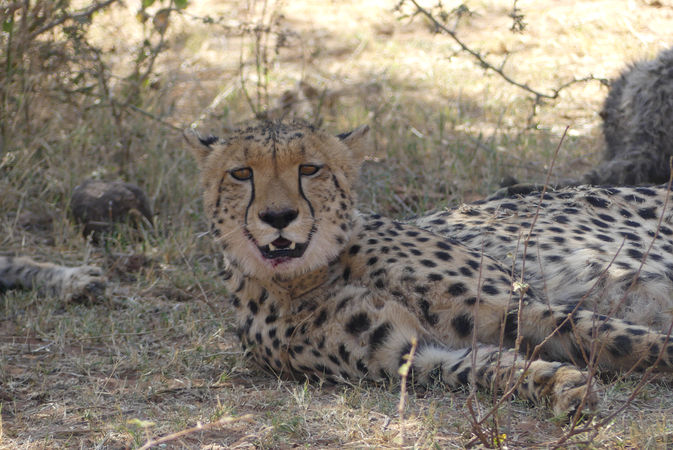
Respiration

Cheetahs are well known for their extraordinary sprinting capabilities but let's dig a little deeper and take a look at functions like their respiration process which contributes tremendously to sprinting ability. When we think of respiration, we usually know that the respiration process usually takes place in the lungs where oxygen comes in and CO2 exits out through either the nose or the mouth. Because cheetahs rely so much on pure speed, they have made several adaptations as mentioned by SeaWorld Parks and Entertainment, "cheetahs possess an enlarged heart, oversized liver, adrenals, bronchi, and lungs, and large arteries." Furthermore, they mentioned that cheetahs have "fast-twitch" muscle fibers that override power over endurance. The "fast-twitch" muscle fibers are only available for a couple of minutes during the hunting process when the "supply of oxygen is reduced through anaerobic respiration." To go in-depth in terms of skeletal muscle profile for these elite sprinters, there was an investigation conducted in Namibia where they captured 3 wild adult cheetahs and compared their capacity for anaerobic and aerobic metabolism with 3 captive adults.

As mentioned in the research paper titled "Skeletal muscle histology and biochemistry of an elite sprinter, the African cheetah" by T.M. Williams and his team, their main priority was to figure out cheetahs capacity for aerobic metabolism from which
they'll be able to "determine the fiber-type profiles, metabolic enzyme capacities, myoglobin (Mb) content, and mitochondrial volume density of three major limb muscles: vastus lateralis, gastrocnemius, and soleus."


From the results, they were able to determine that 61% of the muscle fibers population were made up of the fast-twitch fibers in the gastrocnemius and almost 83% of the vastus lateralis of the cheetahs. They reported that the cheetah's myoglobin concentration in the vastus lateralis was similar to other terrestrial sprinters and endurance runners. They also found out that the lactate dehydrogenase (LDH) activity, which is responsible for the production of energy, of cheetah's vastus lateralis were two times higher than compared to the level in horses. Along with that, they also reported that the cheetah's myoglobin content, important for oxygen storage, was also two times greater compared to a Cape hunting dog who is an endurance specialist, which gives you a great perspective on how they have become the fastest animal on earth.

To put it all into perspective, when the cheetah initially starts running or starts chasing the prey, the cheetah produces its energy through aerobic respiration, in which its cell starts to break down food that’s coming to the cell using oxygen as a power source in order to generate lots of ATP. The basic chemical reaction that occurs is this formula C6H12O6+6O2-->6CO2+6H2O where it produces about 36 ATP/glucose at a relatively slow pace.
The major steps that take place in aerobic respiration are glycolysis where glucose is broken down, Kreb's cycle stage where it undergoes series of reactions, and finally ending in the electron transport system stage. Now, because the cheetah needs additional ATP in order to be quick and to keep up with the prey, it then starts anaerobic respiration which always occurs in the cytoplasm of the cell. Cheetahs use the lactate fermentation pathway to reoxidize the reduced NAD so it can be reused in glycolysis. Lactate fermentation occurs mostly in muscle tissue where the demand for ATP for muscle contraction is high and there is an oxygen deficit. In the lactate fermentation pathway, a molecule of pyruvate which was produced during glycolysis, accepts the hydrogen atoms from the reduced NAD-also made in glycolysis. This is catalyzed by the enzyme lactate dehydrogenase and it results in the formation of lactate and oxidized.
This oxidized NAD can then go back and accept more hydrogen atoms from triosephosphate during glycolysis. This allows ATP production from glycolysis to continue. Although it seems like cheetahs have found a cheat code to life, the issue with this type of respiration is that lactate is acidic so if it is not removed from the

muscle tissue, it can lower pH in the tissues and inhibit the actions of important enzymes. To prevent this from occurring, the lactate produced is transported to the liver where it is converted back to pyruvate when more oxygen is available. Relative to other organs, the cheetah muscle is well adapted for anaerobic glycolysis (Castellini, Somero, and Kooyman 1981).


